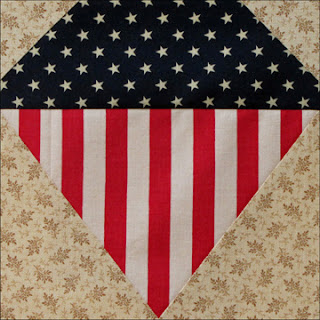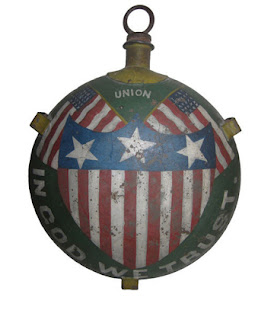Union Shield
by Becky Brown
Becky used striped fabric.
Shield from a sampler than looks to be
from the late in the 19th century
http://barbarabrackman.blogspot.com/2011/03/northern-lily-southern-rose-block-1.html
Union Shield
By Rosemary Youngs
Rosemary made her own stripes.
Union canteen
The image was popular during the War to represent the Union.
I think these were called earbobs at the time.
Parcheesi board about 1880
Shields remain popular as a symbol of the country.
Cutting an 8'' Finished Block
Here's a link to a PDF with the templates:
https://acrobat.com/app.html#d=jYEHIcLvbLo1HIF2UrXcXw
Here's a link to a PDF with the templates:
https://acrobat.com/app.html#d=jYEHIcLvbLo1HIF2UrXcXw
B Cut a starry blue rectangle 8 1/2'' x 3 1/4''. Trim using template B.
C Cut a background rectangle 4 3/4'' x 6 1/4''. Cut into two triangles from corner to corner with one cut. This is also on the template page.
D Cut a striped red fabric into a rectangle 9'' x 5 7/8''. The stripes should run parallel to the short sides. Use template D to trim into a rectangle.
Repeated blocks make a patriotic miniquilt.
Alternated with the pieced star in week #41.
The shield goes right to the edge of the block so
sashing provides a little visual space around it.
Here's a mockup without sashing I made from photos of Becky's blocks.
This is the last of the blocks, but not the last of the posts. I'll keep you updated with pictures of finished quilts and news on the book and new Civil War reproduction fabric lines. Subscribe through email (see top left) and you'll get a note when there's a new post.
The shield just seems perfect the way it is but there were other drafts.
Here's an idea that was rejected.
























































